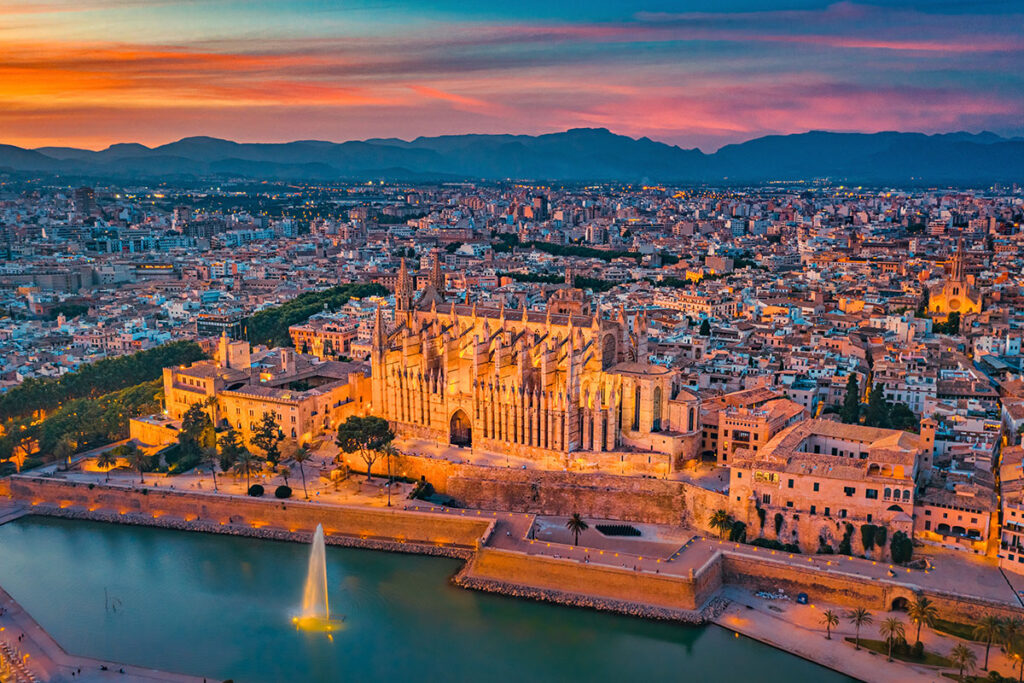If you think that the Sagrada Familia has been built for a long time, then get to know the temple that was built even longer, for almost four hundred years!
La Seu Cathedral is located in the heart of Majorca’s capital city, Palma de Mallorca. It is a three-nave temple with a total area of 6,600 m2, which is a typical example of Mediterranean Gothic. Its enormous size, including the cathedral’s nave, which is 44 meters high, places it among the largest cathedrals in the world.
Huge on the outside, spacious on the inside
We will find out about the spaciousness of this temple by going inside. The huge interior is devoid of unnecessary details, which was rather rare in this type of medieval religious sites. On the other hand, in the case of the La Seu, it is difficult to talk only about the era in which its construction began. Considering that it lasted for several consecutive centuries, and significant modernization took place even in the 20th century, the architecture of this building also includes many solutions from other periods of time.
The history of the cathedral
Construction of La Seu on the site of the former mosque began in 1229 and was definitely not the easiest one. The great momentum of the temple construction works exceeded the architects’ initial assumptions. Soon women and children were hired to work. Stones from different parts of the island were used as building material and then processed.
In the years 1347-1377, works on the construction works were suspended. It was the result of the conflict that continued at that time between Peter of Aragon IV (Pedro IV de Aragón) and James III (Jaume III). The construction was continued thanks to the clergy who, promising eternal life to the faithful, encouraged them to make donations. These allowed for the completion of one of the chapels and two bays of the nave.
In 1490 there was a disaster. The vault in the middle of the building collapsed. Decades of work have allowed for its improvement and reconstruction. In 1587, work on the nave and aisles was completed, while 1601 is considered the final date of the completion of the cathedral. It is “considered” to be such because the subsequent major modifications of La Seu were made several more times. The problem of the collapsing vault returned four times, while the quake in 1851 destroyed a large part of the front of the temple. All this meant that at the end of the 19th century a decision was made to modernize the cathedral’s architecture.

The changes were visible not only from the outside, but also from the inside. The biggest modification was the change in the layout of the chancel, undertaken by Antonio Gaudi. The artist was also responsible for the design of the chandelier resembling a crown of thorns, the design of the iron candelabra around the columns, as well as the mosaic located in the chancel. The effects of his works are criticized by some and admired by others.
Giant rosette “Eye of the Gothic”
La Seu is impressive not only from the outside. What immediately draws visitors’ attention in its interior are over 60 colorful stained glass windows and 5 stained glass rosettes. The largest one was built in 1370 and has a diameter of 13.8 m. The locals call it a gothic eye. More than 1,000 pieces of glass were used to make this rosette, which had previously been carefully sanded.
An interesting solution was to place the gothic eye not on the main facade, but above the chancel. Such a location is not accidental, especially when we think of an amazing spectacle of colors that we can see inside. It is particularly impressive in the morning, when the sun emerging from behind the horizon comes in through the stained glass windows, painting the interior of the cathedral with various colors.
Light phenomena in the cathedral of La Seu
We will see an interesting light phenomenon in the cathedral on 2 February (Feast of the Presentation of the Lord) and on November 11 (the memory of Saint Martin of Tours). Then the light shining through the gothic eye creates a colorful picture on the opposite wall, which is located just under the rosette located there. You can see it in the video below:
We will see a different light phenomenon between 20 and 23 December (winter solstice). Then the rising sun, passing through the rosette opposite the gothic eye, illuminates the former one. It creates an amazing color effect from the outside, which we will not notice on other days of the year. This is shown in the video below:
La Seu Cathedral Museum
There is yet another interesting place hidden in La Seu in Mallorca. It is the Cathedral Museum (Museu de la Catedral), where we can find a lot of religious exhibits that have been collected here since the Middle Ages. The collection includes: silver monstrances from the 16 th century, decorative candelabra, reliquaries, gothic sculptures and paintings, as well as archival photos of the cathedral.
Practical info
- It’s best to buy tickets to the La Seu Cathedral in advance. You will then avoid standing in a long queue and avoid the risk that all tickets have been sold out.
- Address: Plaça de la Seu, s/n, 07001 Palma, Illes Balears, Spain
- Buy Tickets on GetYourGuide
